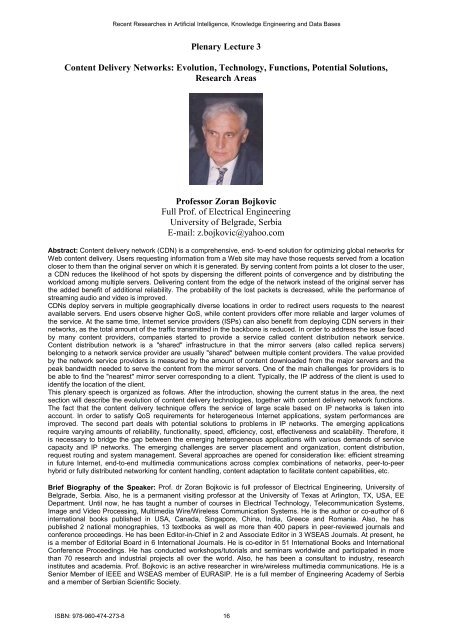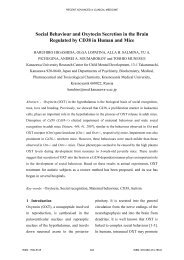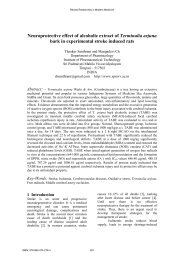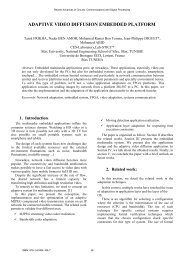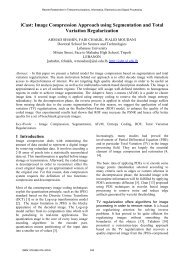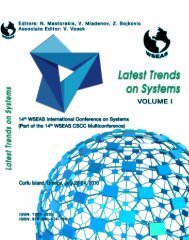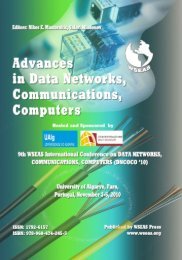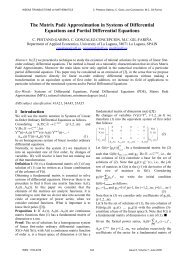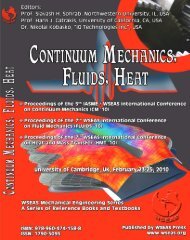Recent Researches in Artificial Intelligence, Knowledge ... - Wseas.us
Recent Researches in Artificial Intelligence, Knowledge ... - Wseas.us
Recent Researches in Artificial Intelligence, Knowledge ... - Wseas.us
Create successful ePaper yourself
Turn your PDF publications into a flip-book with our unique Google optimized e-Paper software.
<strong>Recent</strong> <strong>Researches</strong> <strong>in</strong> <strong>Artificial</strong> <strong>Intelligence</strong>, <strong>Knowledge</strong> Eng<strong>in</strong>eer<strong>in</strong>g and Data Bases<br />
Plenary Lecture 3<br />
Content Delivery Networks: Evolution, Technology, Functions, Potential Solutions,<br />
Research Areas<br />
Professor Zoran Bojkovic<br />
Full Prof. of Electrical Eng<strong>in</strong>eer<strong>in</strong>g<br />
University of Belgrade, Serbia<br />
E-mail: z.bojkovic@yahoo.com<br />
Abstract: Content delivery network (CDN) is a comprehensive, end- to-end solution for optimiz<strong>in</strong>g global networks for<br />
Web content delivery. Users request<strong>in</strong>g <strong>in</strong>formation from a Web site may have those requests served from a location<br />
closer to them than the orig<strong>in</strong>al server on which it is generated. By serv<strong>in</strong>g content from po<strong>in</strong>ts a lot closer to the <strong>us</strong>er,<br />
a CDN reduces the likelihood of hot spots by dispers<strong>in</strong>g the different po<strong>in</strong>ts of convergence and by distribut<strong>in</strong>g the<br />
workload among multiple servers. Deliver<strong>in</strong>g content from the edge of the network <strong>in</strong>stead of the orig<strong>in</strong>al server has<br />
the added benefit of additional reliability. The probability of the lost packets is decreased, while the performance of<br />
stream<strong>in</strong>g audio and video is improved.<br />
CDNs deploy servers <strong>in</strong> multiple geographically diverse locations <strong>in</strong> order to redirect <strong>us</strong>ers requests to the nearest<br />
available servers. End <strong>us</strong>ers observe higher QoS, while content providers offer more reliable and larger volumes of<br />
the service. At the same time, Internet service providers (ISPs) can also benefit from deploy<strong>in</strong>g CDN servers <strong>in</strong> their<br />
networks, as the total amount of the traffic transmitted <strong>in</strong> the backbone is reduced. In order to address the issue faced<br />
by many content providers, companies started to provide a service called content distribution network service.<br />
Content distribution network is a "shared" <strong>in</strong>frastructure <strong>in</strong> that the mirror servers (also called replica servers)<br />
belong<strong>in</strong>g to a network service provider are <strong>us</strong>ually "shared" between multiple content providers. The value provided<br />
by the network service providers is measured by the amount of content downloaded from the major servers and the<br />
peak bandwidth needed to serve the content from the mirror servers. One of the ma<strong>in</strong> challenges for providers is to<br />
be able to f<strong>in</strong>d the "nearest" mirror server correspond<strong>in</strong>g to a client. Typically, the IP address of the client is <strong>us</strong>ed to<br />
identify the location of the client.<br />
This plenary speech is organized as follows. After the <strong>in</strong>troduction, show<strong>in</strong>g the current stat<strong>us</strong> <strong>in</strong> the area, the next<br />
section will describe the evolution of content delivery technologies, together with content delivery network functions.<br />
The fact that the content delivery technique offers the service of large scale based on IP networks is taken <strong>in</strong>to<br />
account. In order to satisfy QoS requirements for heterogeneo<strong>us</strong> Internet applications, system performances are<br />
improved. The second part deals with potential solutions to problems <strong>in</strong> IP networks. The emerg<strong>in</strong>g applications<br />
require vary<strong>in</strong>g amounts of reliability, functionality, speed, efficiency, cost, effectiveness and scalability. Therefore, it<br />
is necessary to bridge the gap between the emerg<strong>in</strong>g heterogeneo<strong>us</strong> applications with vario<strong>us</strong> demands of service<br />
capacity and IP networks. The emerg<strong>in</strong>g challenges are server placement and organization, content distribution,<br />
request rout<strong>in</strong>g and system management. Several approaches are opened for consideration like: efficient stream<strong>in</strong>g<br />
<strong>in</strong> future Internet, end-to-end multimedia communications across complex comb<strong>in</strong>ations of networks, peer-to-peer<br />
hybrid or fully distributed network<strong>in</strong>g for content handl<strong>in</strong>g, content adaptation to facilitate content capabilities, etc.<br />
Brief Biography of the Speaker: Prof. dr Zoran Bojkovic is full professor of Electrical Eng<strong>in</strong>eer<strong>in</strong>g, University of<br />
Belgrade, Serbia. Also, he is a permanent visit<strong>in</strong>g professor at the University of Texas at Arl<strong>in</strong>gton, TX, USA, EE<br />
Department. Until now, he has taught a number of courses <strong>in</strong> Electrical Technology, Telecommunication Systems,<br />
Image and Video Process<strong>in</strong>g, Multimedia Wire/Wireless Communication Systems. He is the author or co-author of 6<br />
<strong>in</strong>ternational books published <strong>in</strong> USA, Canada, S<strong>in</strong>gapore, Ch<strong>in</strong>a, India, Greece and Romania. Also, he has<br />
published 2 national monographies, 13 textbooks as well as more than 400 papers <strong>in</strong> peer-reviewed journals and<br />
conference proceed<strong>in</strong>gs. He has been Editor-<strong>in</strong>-Chief <strong>in</strong> 2 and Associate Editor <strong>in</strong> 3 WSEAS Journals. At present, he<br />
is a member of Editorial Board <strong>in</strong> 6 International Journals. He is co-editor <strong>in</strong> 51 International Books and International<br />
Conference Proceed<strong>in</strong>gs. He has conducted workshops/tutorials and sem<strong>in</strong>ars worldwide and participated <strong>in</strong> more<br />
than 70 research and <strong>in</strong>d<strong>us</strong>trial projects all over the world. Also, he has been a consultant to <strong>in</strong>d<strong>us</strong>try, research<br />
<strong>in</strong>stitutes and academia. Prof. Bojkovic is an active researcher <strong>in</strong> wire/wireless multimedia communications. He is a<br />
Senior Member of IEEE and WSEAS member of EURASIP. He is a full member of Eng<strong>in</strong>eer<strong>in</strong>g Academy of Serbia<br />
and a member of Serbian Scientific Society.<br />
ISBN: 978-960-474-273-8 16


